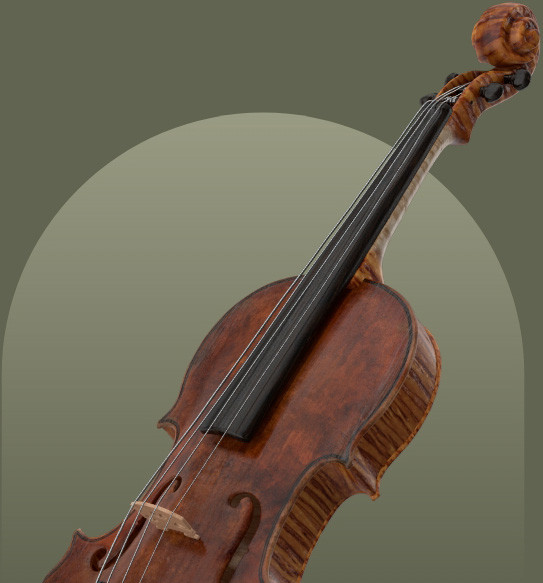John Dilworth
HILL, William Ebsworth Born 1817, Worked from 1831 London UK, died 1895 Fourth son of Henry Lockey Hill, above. Apprenticed to Charles Harris (II) in Oxford after the death of his father in 1835, returning to London in 1838 to live at St George’s Road, Borough, the home of his elder brother Joseph (IV) who died in that year. Soon after this date he began working with James Tubbs, whose bows received W. E. Hill brands. In 1866 he moved to Waterloo Road, and then to Wardour Street. In 1880 he established the firm of W. E. Hill & Sons which transferred to New Bond Street in 1882. Assisted by his sons, William Henry, Arthur Frederick, Alfred Ebsworth, and Walter Edgar, this shop grew into the most respected and admired centre of violin expertise in the world. William Ebsworth Hill’s fame rests on his expertise and restoration skills. He ceased making new instruments quite early in his career and the work is very much of its period, clearly showing the influence of Lockey Hill and Charles Harris rather more than a direct familiarity with authentic Cremonese instruments. William E. Hill / Maker London / 1852 [BVMA]
William Meredith Morris
One of the greatest names in fiddle lore. Full justice has been done to his life and work in the very able sketch by the late Rev. H. R. Haweis, in “Old Violins,” to which the reader is referred.
George Hart
Son of Lockey Hill. Made several instruments in his younger days, but, like the rest of our English makers, he long since discovered that new work was unremunerative, and turned his attention to repairing and dealing in old instruments, whereby he enjoys his full share of patronage from the Violin world. He exhibited at the Exhibition of 1862 a Violin and Tenor, thus showing that Violin-making was not quite extinguished in England.
Cecie Stainer
Son of Henry Lockey Hill; b. Oct. 20. 1817; d. April 2. 1895. A maker in London. Learnt from his elder brother. Joseph. Began by making violin-bridges, always beautifully shaped and designed ; quite 200 are still preserved by the firm. He worked for a year with Charles Harris, at Oxford, returning to London, 1838.
First worked in Southwark, then in Wardour Street, and finally removed to 38, New Bond Street. When he began to repair and deal in old instruments he did everything with his own hands, and had no assistants until his sons grew up. He exhibited some very beautiful violins of carefully finished work and an excellent viola of large pattern, with full round tone, in London, in 1862, obtaining special commendation and a prize medal.
Probably few, if any, of W. E. Hill’s contemporaries had such a wide and thorough knowledge of the art and craft of violin making as he himself. Those who had the pleasure of knowing him personally found his conversation full of the most interesting facts and reminiscences, while at the same time a kindly, straightforward, and unassuming manner, peculiarly his own, made him the object of general regard and respect.
His death removed one who was a prominent and characteristic link between modern times and a bygone type of personality. His four eldest sons became members of the firm : William Henry, b. June 3, 1857, followed the musical profession for some years, before joining his brothers in the business ; Arthur Frederick, b. Jan. 25, 1860 ; Alfred Ebsworth, b. Feb. 1862, who worked for some time at Mirecourt (Vosges) and was the first Englishman to go there to study ; and Walter Edgar, b. Nov. 4, 1871, d. 1905, who also worked at Mirecourt. They employ a large staff of assistants in their workshops at Hanwell.
Willibald Leo Lütgendorff
Jüngerer Sohn von Henry Lockey H. und Schüler seines älteren Bruders
Joseph (IV.). Als er in die Lehre trat, wurde er zuerst mit dem Stegschnitzen
beschäftigt und erlangte darin eine erstaunliche Fertigkeit. Noch in den letzten
Jahren seines Lebens war es eine Lieblingsbeschäftigung von ihm, zum Vergnügen
Stege zu schneiden. Nach Beendigung seiner Lehrzeit trat er bei
Charles Harris in Oxford ein und eröffnete, nach London zurückgekehrt, im
Jahre 1830 seine eigene Werkstatt im Southwark. Als das Geschäft sich ausdehnte,
verlegte er es nach dem Hauptquartier des Londoner Geigenhandels, der
Wardour Street. Obwohl seine Geschicklichkeit im Geigenmachen Anerkennung
fand, machte er doch sehr schnell — wie so viele neuere Meister — die Erfahrung,
dass Musiker und Liebhaber der besten neuen Arbeit jede beliebige
Geige vorziehen, wenn sie nur alt ist und italienisch aussieht. Er verlegte sich
daher von Anfang an hauptsächlich auf die Wiederherstellung und den Handel
mit alten Geigen. Auf diesem Gebiete hat er dann, Dank seinem Scharfblick
und einer seltenen Kennerschaft, ausserordentliche Erfolge erzielt. Dass er aber
auch im Neubau etwas zu leisten im Stande war, hat er nicht nur in seiner
Jugend schon, sondern noch 1862 bewiesen, da er ein Meisterwerk ausstellte,
»um der Welt zu zeigen, dass das Geigenmachen in England noch nicht ausgestorben
sei«. Auch seine vier Söhne erzog er zu tüchtigen Geigenmachern
heran, nahm sie in sein Geschäft als Theilhaber auf und überliess es ihnen ganz, nachdem es in die New Bond Street verlegt worden war. Er zog sich auf seine Besitzung in Hanwell zurück und arbeitete hier noch einige Zeit für sich, bis ihn der Tod von zunehmender Altersschwäche erlöste. Als Kenner hatte er einen Weltruf erlangt,
und ein von ihm ausgestelltes Zeugniss der Echtheit einer Geige gilt bei Musikern, Sammlern und Händlern als unanfechtbar.
